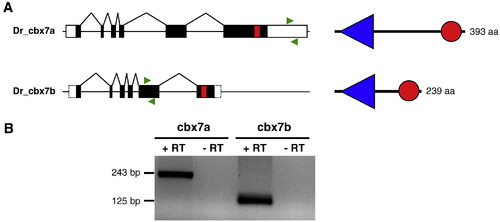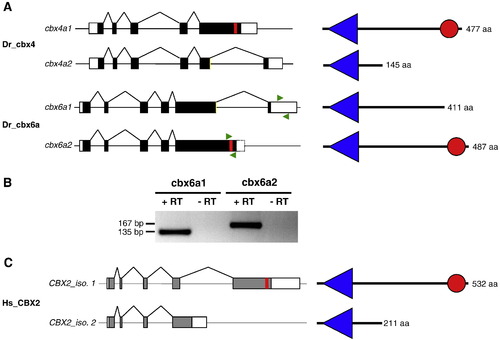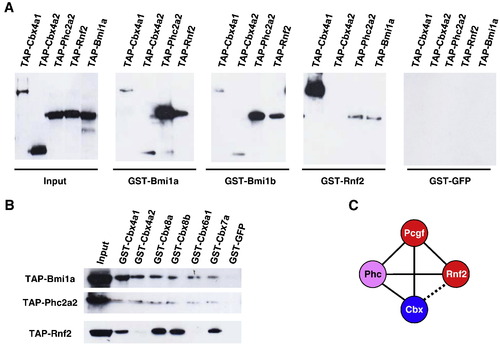- Title
-
The zebrafish genes encoding the Polycomb Repressive Complex (PRC) 1
- Authors
- Le Faou, P., Völkel, P., and Angrand, P.O.
- Source
- Full text @ Gene
|
cbx7a and cbx7b are expressed in zebrafish larvae. (A) Schematic representation of zebrafish cbx7a and cbx7b genes and proteins. On the gene organization cartoons, white parts indicate untranslated regions whereas red parts correspond to regions coding for the Pc boxes. On the protein drawings, the chromodomain is indicated as a blue triangle and the Pc box as a red circle. Amino acid length of the proteins is indicated. Position of primers used for the RT-PCR is shown as green arrows. (B) Detection of cbx7a and cbx7b transcripts in zebrafish larvae by RT-PCR. Total RNAs were extracted from 5 dpf zebrafish larvae and subjected to reverse transcription and PCR amplification using primers specific for cbx7a and cbx7b, as indicated in (A), in presence (+ RT) or absence (- RT) of reverse transcriptase. The expected size of the PCR products is 243 and 125 bp for cbx7a and cbx7b, respectively. EXPRESSION / LABELING:
|
|
CBX isoforms lacking the Pc box. (A) Schematic representation of zebrafish cbx4 and cbx6a transcripts and proteins. On the transcript cartoons, white parts indicate untranslated regions whereas red parts correspond to regions coding for the Pc boxes. On the protein drawings, the chromodomain is indicated as a blue triangle and the Pc box as a red circle. Amino acid length of the proteins is indicated. Primers used for the RT-PCR are shown as green arrows. (B) Detection of cbx6a1 and cbx6a2 transcripts in zebrafish larvae by RT-PCR. Total RNAs were extracted from 5 dpf zebrafish larvae and subjected to reverse transcription and PCR amplification using primers specific for cbx6a1 and cbx6a2, as indicated in (A), in presence (+ RT) or absence (- RT) of reverse transcriptase. The expected size of the PCR products is 135 and 167 bp for cbx6a1 and cbx6a2, respectively. (C) Schematic representation of human CBX2transcripts and proteins. White parts indicate untranslated regions whereas the Pc box coding region is shown in red on the CBX2 isoform 1 transcript. On the protein drawings, the chromodomain is indicated as a blue triangle and the Pc box as a red circle. Amino acid length of the proteins is indicated. EXPRESSION / LABELING:
|
|
Interactions between zebrafish PRC1 components. (A) GST pull down experiments showing that Bm1a and Bmi1b directly interact with Rnf2 and the isoforms Cbx4a1, Cbx4a2 and Phc2a2, and showing that Rnf2 directly interacts with Cbx4a1, Phc2a2 and Bmi1a, but not with the Cbx4 isoform lacking the Pc box, Cbx4a2. GST-tagged Bmi1a, Bmi1b, Rnf2 and GFP as a control were expressed in E. coli, bound to glutathione-Sepharose, and incubated with in vitro expressed TAP-tagged Cbx4a1, Cbx4a2, Phc2a2, Rnf2 or Bmi1a proteins, as indicated. After washing, proteins were separated by SDS-PAGE and Western blots probed with peroxidase anti-peroxidase (αPAP) antibodies to reveal TAP-tagged proteins. (B) The Cbx Pc box is required for direct interaction with Rnf2, but not required for Cbx interactions with Phc2a2 and Bmi1a. GST-tagged Cbx4a1, Cbx4a2, Cbx8a, Cbx8b, Cbx6a1, Cbx7a and GFP as a control were expressed in E. coli, bound to glutathione-Sepharose, and incubated with in vitro expressed TAP-tagged Bmi1a, Phc2a2 or Rnf2 proteins, as indicated and Western blots performed as indicated in (A). (C) Schematic representation of interactions between zebrafish PRC1 components in vitro. The dashed line indicates that the interaction occurs with Pc box-containing Cbx isoforms, but not with Cbx isoforms lacking the Pc box. |
Reprinted from Gene, 475(1), Le Faou, P., Völkel, P., and Angrand, P.O., The zebrafish genes encoding the Polycomb Repressive Complex (PRC) 1, 10-21, Copyright (2011) with permission from Elsevier. Full text @ Gene



